All those who used wooden material, such as a lining, in the plating of their house or bathhouse, had to decide whether it should be painted in different colors or coatings with a certain composition.
If the decision was made, that the coating on the forcing should be, then the next difficulty is the determination of a specific means for painting. Therefore, it is necessary to become more familiar with the proposed materials and the subtleties of their application.
What is it used for?
Primarily, what comes to mind to those who have a question about the need to paint the lining inside the premises - is it worth it to do at all? All the pros and cons of such an event will help clarify the situation.
Wood coated:
Without cover:
- If the material for the skin was not used too expensive, then you can periodically replace it, because the means for processing wood are not cheap.
- Those who like the color of the old tree may not resort to the use of wood coating.
Tools for processing
As for the funds themselves, which are used for processing lining inside the premises, they have species separation depending on the functions performed and the available properties:
- Protective action
Compositions necessary to preserve the integrity of the wood structure, which is broken by insects, fungi, decay processes, and also prevents drying. Usually it is a primer or impregnation.

Features that you should pay attention to when choosing decorative coating:
- Colour.
- Composition.
- Manufacturer.
This feature of paint or varnish is selected depending on the interior of the room. Interior design can be selected from the photo on the Internet.
Using the pigmentation means, you can make the zoning of the room or visually expand the space, applying in the coloring of light colors.
And you can choose the composition without the pigment, which emphasizes the wooden texture.
For many, components are very important composition of chemicals, namely the absence of those that are harmful to the body.
All paints or varnishes on which there is a prefix "bio" do not pose a danger to humans. They are used for indoor coating.
On this criterion, it is worth paying attention to not overpaying "for the mark". There are many varieties of paints and varnishes produced in the Russian Federation, which in quality are not inferior to European ones.
Than to process a lining?
Another nuance that can not be avoided, determined in the means for painting the lining indoors - this is the place of painting. In order not to be mistaken in the parameters of the selected tool for processing, it is necessary to know the features of the choice for premises of different types.
Bath or steam room
Due to the fact that the temperature regime in this room is always increased, you should refrain from painting its walls.
You only need to process the walls with a compound that will provide protection to the carpet. These funds include wax-containing varnishes. It is also worth noting that the application in the sauna itself should be carried out in a single layer, in the dressing room can be processed in two or three layers.
Balcony
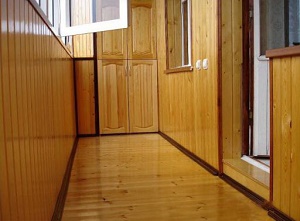 Given that the open space of the balcony or verandah is exposed to various environmental factors, it should initially be applied to the lining soil, then paint with paint or varnish.
Given that the open space of the balcony or verandah is exposed to various environmental factors, it should initially be applied to the lining soil, then paint with paint or varnish.
Inside the house
The first requirement for the chosen means for processing in such a place is the degree of ecological compatibility, the most environmentally friendly remedy should be chosen.
The processing itself depends on the chosen means, but it is desirable to carry out in several layers, especially if it is a paint or a pigmented varnish.
Examples of interior design with painted lining:

Staining stages:
- The application of any paint and varnish coating is carried out under the conditions of the temperature regime within 5-30 degrees above zero.
- Movement during painting should be from top to bottom.
- Paint before application, it is desirable to dilute to a more liquid consistency, like milk.
- The part of the lining, which does not need to be painted, is recommended to be pasted with a paint tape.
Such a parameter can be changed by the manufacturer, which will be indicated on the packaging. If the temperature is lower than this, it promises freezing of the composition, and if it is too high, the applied coating may dry out with uneven fragments.
This will allow thin layers paint, significantly save time, effort and paint consumption, and also speed up drying.
Those places that are located near the tape should be painted over using small brush, using the minimum amount of funds. So you can be sure that the composition does not fall under the scotch and the surface to be painted will be flat at the edges.
Painting the lining wax and oil - see the video:
With interior decoration of houses and interior decoration, many prefer natural materials. One of them is a lining. In this article we will consider how you can decorate the room with this material and answer the question about painting the lining.
Building material - lining
The lining can be called a universal building material. I wonder why this material is called so. It turns out that earlier the railway cars were trimmed with thin racks with a groove-comb attachment system. Modern lining is made of the following types of wood:
- coniferous (pine, spruce, fir);
- deciduous (oak, alder, linden, etc.).
In this case, the material from each tree species has its own unique color and wood pattern. It also has medicinal properties inherent in a particular tree. Like other sawnwood, it has a division into varieties:
- variety Extra - the board has no defects, and has excellent quality and aesthetic appearance;
- variety A - should not be present cracks, large knots and pitch, ingrown knots of light color are supposed;
- variety B - on the surface of the board there may be knots of light color and cracks up to 1 mm, as well as shells from fallen knots of no more than 5 mm;
- variety C - all the above-described defects may be present.
Of course, for interior decoration of rooms it is best to choose varieties Extra and A. They will decorate any interior and create in it an atmosphere of warmth and coziness.
interior lining
The interior decoration of the walls and ceiling in the room with the lining is very interesting, and, most importantly, no other finish is required. This method has its advantages and disadvantages. The positive aspects include:
- environmentally friendly material;
- economically profitable;
- warm and pleasant material;
- easy installation;
- suitable for use on all surfaces;
- the ability to hide wall defects and communications.
Negative qualities include:
- treatment with antiseptics and fire-fighting compounds;
- the need for high quality lining;
- periodic coating of paint and varnish materials.
These items can not be called negative qualities, but necessary measures to preserve the integrity of the timber and your safety. The interior of the lining is good in itself, and does not require unnecessary details. For example, the living room is decorated with honey-colored material. It is enough to hang simple curtains of natural shade on the windows. Put the wicker furniture with light cushions and complement all lighting devices with a simple form. The result is a cozy and pacifying interior. And you can paint the lining. About what are the colors for this and whether it is possible to paint this material in general, let's talk further.
Can I paint a lining, than color it?
Of course, like any other lumber can be painted. The main thing for this is to choose the type of coverage for different types of material. The board is divided into two large groups:
- facade;
- internal.
Depending on the purpose of painting it can be different materials. Consider in more detail than usual color the outer board. Outside, all materials are affected by atmospheric precipitation, sun and temperature changes. Therefore, this lining requires special protection. For these purposes are well suited:
- Semitransparent antiseptics - are able to be absorbed into the tree by a few millimeters and are well protected against the adverse effects of external factors. This antiseptic completely preserves the pattern and color of the wood.
- Opaque antiseptics - completely cover the lining, preserving only the relief of the tree.
- Oil paints - well cover the surface of the tree and soak into its structure. They provide good protection against weathering. The main drawback is the slow drying, within 7 hours, and the color change with time.
- Acrylate paints - much more elastic than oil, do not crack with time and retain rich color and shine. Also they are much more environmentally friendly than other analogues.
- Alkyd varnishes have a long service life of 5 to 10 years.
Of all the above materials, it is best to use translucent antiseptics. They will preserve the external beauty of the tree and protect it well against the negative impact of external factors.
than painting the lining inside the house
Lining in recent years has become popular for interior decoration. But it is not enough to cover the walls and ceiling with it, it is necessary to choose another cover. Materials for coating wood outside the house, we have already considered. The inner coating should be safe, dry quickly and do not have any sharp odors. All decorative coatings are divided into two large groups:
- Protective - a variety of antiseptic compositions that prevent damage to wood by fungi, insects.
- Decorative - give a beautiful appearance due to different application techniques, they can include paint, stains, decorative glaze.
All coatings are diverse and beautiful in their own way. When choosing a cover, someone prefers security, but to someone, aesthetic qualities are important. In order to understand what this or that coating gives, we will consider each of them separately:
- Oil paint It is durable, does not pass moisture and dries quickly. Painting her room should be in the warm season, when it is possible to ventilate the room from a sharp smell. After about five years, the coating will begin to lose its luster and need to be renewed. On average, this paint costs from 300 to 1500 thousand rubles per bank (depending on the volume).
- Acrylate paint It does not have an unpleasant odor, dries quickly and allows you to work with it even at low temperatures. There is at it one lack, it is high cost in comparison with oil analogues. On average, for a bank of such a paint will have to pay from 400 to 2700 rubles.
- Decorative glaze - due to its transparency, it perfectly emphasizes the structure of the tree. To give it a certain shade, you can add colors. On average, the packaging of this coating will have to pay 700 rubles.
- Stain - emphasizes the texture and natural pattern of the tree, changing its hue. It's easy to apply. For the processing of stain is suitable only vagonka of the highest quality, without defects. Prices for it vary in a wide range from 30 to 3000 rubles per package. To choose a cheap or expensive analogue is already decided by you.
All coatings look very good, protect the wood from drying out and deterioration. With the help of various shades you can give the interior a unique look.
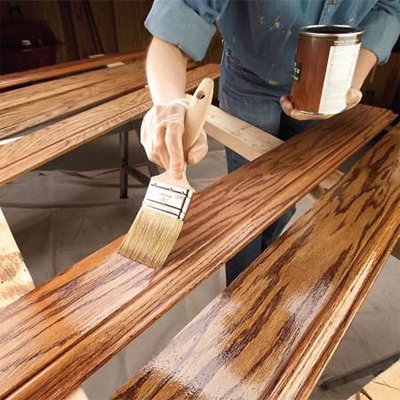
painted lining in the interior
The choice of colors for a particular room is a matter of everyone's taste. Let us consider some examples. For example, the kitchen is clogged with a lining and painted in a gently green color. Such walls are perfectly combined with a white kitchen set and give the whole room freshness and lightness. Perfectly complement the interior pots with indoor plants or herbs on the windowsill.
The children's room can be decorated in a marine style and the walls lined with lining can be covered with a decorative glaze of light color, and the pillars covered with dark stains or paint. The rest of the walls can be painted with blue paint. Complement the interior of several ship accessories in the idea of a rope ladder, and a chest in which you can add toys. Such an interior will soothe and tune in to positive emotions.
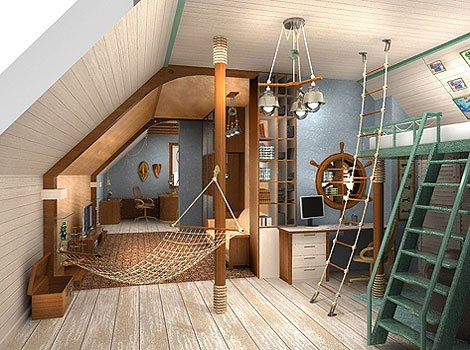
And you can simply cover the tree with varnish or light stain and leave its natural appearance. Such an interior will be cozy and warm. In such a living room it will be nice to get together with family and close friends.
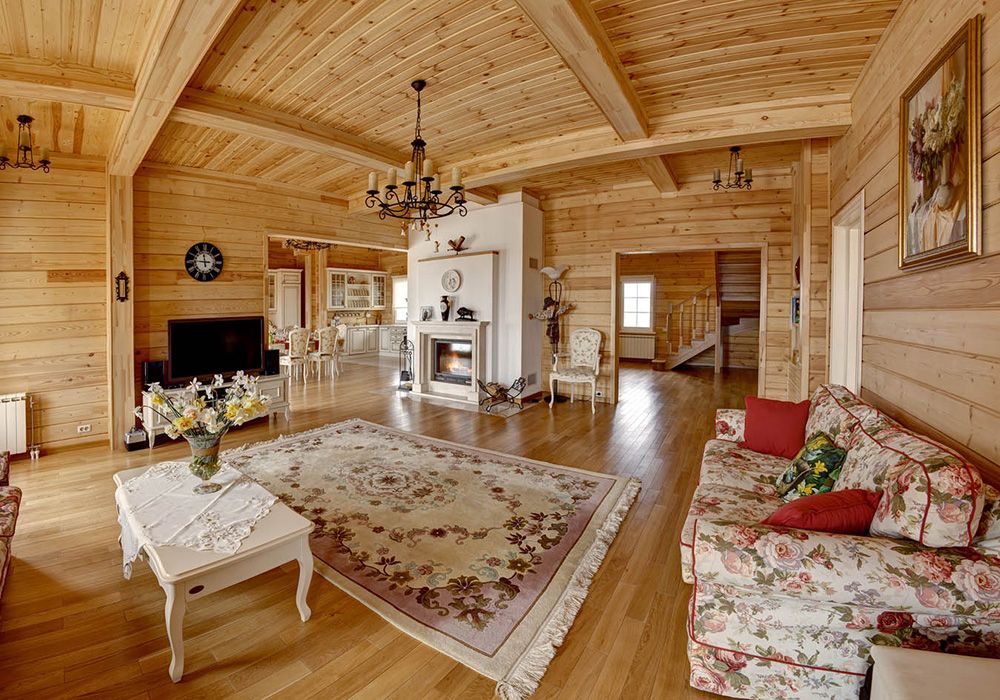
When choosing a coating for lining, you should consider some of their features. They include the following:
- oil paint is capable of changing its color, so it is best to choose a paint of a darker shade;
- oil paints create a dense film on the surface of the wood, not allowing it to breathe;
- water-based paints are safe and environmentally friendly, but are expensive;
- acrylic paints are easy to use and do not spread;
- when using a stain, it must be remembered that it will not protect the tree from moisture;
- water-based paints have a wide variety of colors, which will give the wagon a variety of shades.
It is also necessary to carefully select the color of the interior and remember that:
- shades of beige visually increase space;
- dark colors on the contrary make it smaller;
- the colors of the floor, walls and ceiling must be in harmony with each other and not be contrastive;
- for the bedroom it is best to give preference to the natural color of the tree, and for the office you can pick up and dark shades;
- preferring light colors, it is necessary to remember that it is necessary to clean such a surface more often.
Using these tips, you can determine not only the color of the cover, but also its color.
Using the advice of the article, you will be able to determine the most suitable means for the price and quality to cover the wooden surface in your home. Successful work.
Lining is very popular. It is used for finishing the facades of buildings for various purposes, as well as for internal premises. This material is often decorated with balconies and loggias. However, it should be noted that this natural material requires special care. That's why you need to think carefully about how to process and how to paint the lining on the balcony.
It is a natural finishing material made of wood. Covering from the lining, especially on the balcony, requires protection from the corrosive effects of the external environment. For example, it can be fungi, ultraviolet, increased humidity and more.
One of the options for protective measures is painting. It also performs a decorative function. Depending on the set design tasks, the painting will help to highlight the natural texture of the tree or, conversely, hide and inscribe the finish of the walls and floor of the balcony in the overall interior of the apartment.
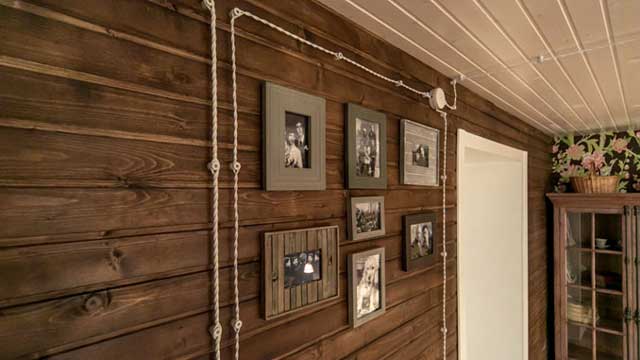
The paneling on the balcony is usually treated using the following means:
- moisture protection compositions;
- various types of antiseptics: transparent and translucent, film-forming and impregnating;
- paints: dispersion and oil;
- every kind of varnish.
Each of them performs its function, has its advantages and disadvantages. Therefore, it is important before you paint the lining on the balcony it is recommended to familiarize yourself with the features of the coatings, their physical characteristics and evaluate the appropriateness of their use.
Treatment with an antiseptic is mandatory for the lining, which is used for balcony lining. Typically, this treatment is carried out before the installation of the finish, and the panels are processed on both sides. Let's see how it is possible to paint the balcony paneling from the lining.
Lucky
If you decide to apply varnish on the lining, it is important to know that the coating obtained can differ in its chemical and physical characteristics. Determining in this matter is the basis of the composition.
- Water. The main advantage of such compounds is their safety. Environmentally friendly materials that are used in production, provide coverage hypoallergenic, almost complete absence of characteristic odor and other advantages.
Among the drawbacks, we can note certain restrictions on their use, which are related to the fact that the coating from the aQUalka is not sufficiently resistant to direct exposure to aggressive external environment, therefore it is recommended to use this type of lacquer only for painting the inner skin made of this material on a glazed balcony or loggia.
- Alkyd. In contrast to the previous version, this varnish can be used practically in any room and in any climatic conditions, because after painting the lining on it a water repellent film is formed. This is especially valuable for areas with high humidity. It is also worth noting that, thanks to the film, the impact resistance of the coating increases.
Among the shortcomings is a sharp smell of varnish and an excessively long period of drying.
- Acrylic. Provide the skin with good protection against direct exposure to ultraviolet and moisture. They do not contain harmful volatile components, that is, they are absolutely safe. Acrylic varnishes are characterized by low cost and a wide range of colors. Before use, the product must be diluted with ether alcohol or water until the desired consistency is obtained. The composition is applied in two layers: the first is protective, and the second is necessary to obtain the desired shade of finish. It can be used both outside and inside the balcony. The varnish layer dries quickly.
- Polyurethane. It is designed exclusively for exterior painting of the lining. It focuses on the important advantages of varnishes on other bases: moisture and frost resistance, effective protection against UV radiation, rapid drying, long service life.
However, as noted above, the polyurethane lacquer is suitable only for external cladding, given its toxicity and specific odor.
For reference!
When performing finishing works, use protective equipment, for example, a respirator, and for lack of such, a dense bandage of gauze.
Criteria for choosing varnish for different rooms
The varnish for wooden panels must comply with the following parameters:
However, choosing a varnish for different rooms, it is necessary to take into account their features:
- Optimal option when finishing the inner skin from the lining - akvalki, because they do not pose any danger to humans or animals. True, they are absolutely not suitable for rooms where the level of moisture, such as a bathroom or kitchen, is increased. Finishing on the balcony is covered with a double layer of akvalak: the first - it functions as an antiseptic, the second layer - decorative.
- Painting the vagonki in the country house primarily plays a protective role. First of all, it protects the coating from direct sunlight and ultraviolet light. The most suitable option for these conditions is acrylic lacquer.
- When processing the skin of the walls in the bath used compounds that are able to withstand extreme temperatures. Synthetic options for solving these problems are not suitable, since in "bath" conditions they will release toxic harmful substances. For such cases paint compounds are more suitable, the main component of which are natural oils. They will preserve the natural balance of this room.
Useful little things
- Minor defects before varnishing, it is preferable to eliminate, using self-made putty from the mixture of sawdust, which remain after cutting the panels of the board, with glue PVA. After the glue dries, the putty on the color will not differ from the color of the walls.
- As already mentioned, tinted varnishes are used to emphasize the texture of wood, which makes the pattern of the carpet more expressive. As an alternative to these varnishes, it is possible to pre-treat the panels with stain.
- When painting lining in two layers, panels with already dried first layer of paint or lacquer are necessarily ground. If this is not done, the sheathing will be rough to the touch, since when the wood is moistened, fine pile rises on its surface.
- When choosing a varnish, give preference to the formulations containing the so-called UV barrier, since in direct exposure to direct sunlight, the wood in these areas darkens.
Paints
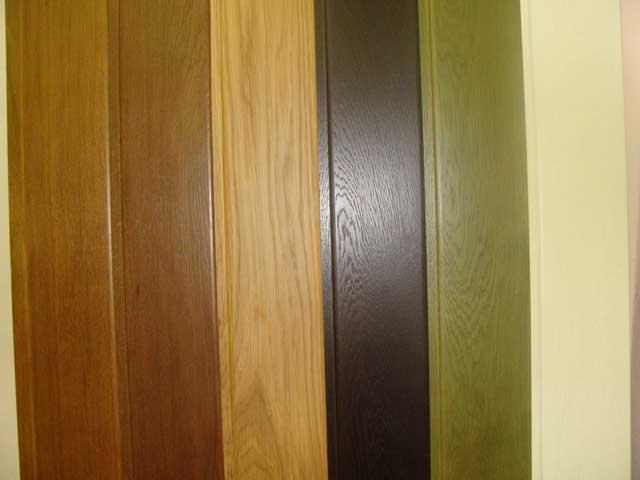
The paint for the lining is used in special cases. Under such a cover, you can hide the defects of the lining or its texture, if design requires it.
- Oily. To cover the lining is suitable oil paint of any brand. It is perfectly absorbed in the structure of the lining, provides a strong protection against moisture, as well as ultraviolet, gives the tree a "breathe". The lining after such treatment becomes more resistant to various aggressive influences, does not crack.
Oil paint can be applied to the inner, as well as to the outer casing of the lining. And yet it is not without drawbacks: first, it slowly dries up - the process lasts no less than 7 hours and can drag on even for a few days until it completely stops sticking, and secondly, the paint of dark tones on the skin will eventually burn out.
- Water based. This is an excellent protection of wood from moisture and ultraviolet rays. Coating from the auldock lasts longer the color saturation and shine, and it dries much faster.
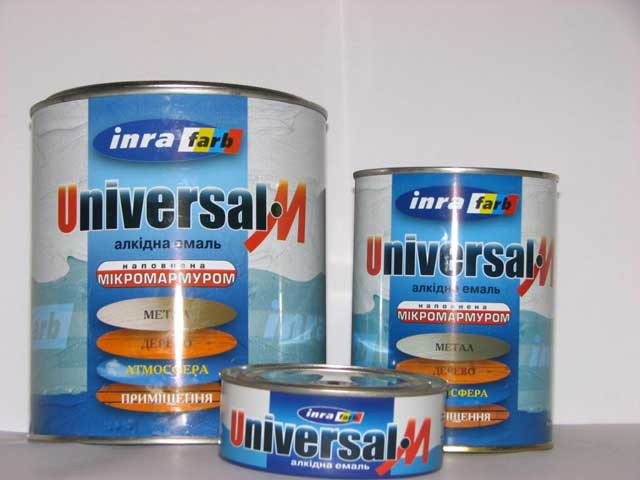
- Thickened alkyd. Paints of this type are produced on the basis of high-quality varnish. The composition is diluted to the desired consistency, preferably using the same substance. When the lining is finished with this paint, a frost-resistant film forms on its surface. She is not threatened with deformation or cracking. Thanks to the film, the skin for many years retains its original appearance. Therefore, this method is especially recommended for those regions where the cold climate prevails.
- Facade. These compounds are characterized by good elasticity, high level of moisture resistance. They are durable, easy to apply, able to mask flaws on the surface of the tree. This paint is also suitable for painting lining with an old coating or a hard-to-clean layer of dust. The only drawback of facade paints is a very small selection of shades.
For reference!
If it is necessary to preserve the texture and color of the wood, it is recommended to use transparent or slightly tinted lacquers. The paint will not only completely hide the texture of the tree, but also completely change the color of the walls to any desired one.
Impregnation
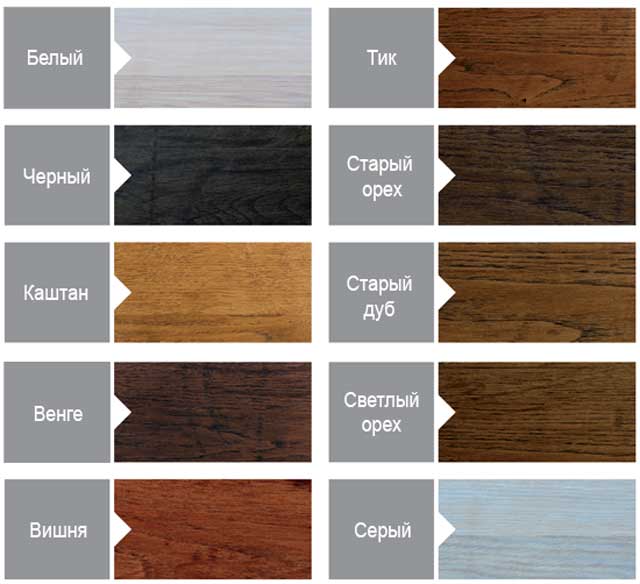
- The simplest way to protect wood is impregnation with stain. At its budget cost, it is quite effective. After qualitative impregnation, the wood will successfully withstand the processes of rotting, the occurrence of mold and the formation of fungus. True, the color range of stain is not particularly diverse. For external processing use a special stain, which contains additives that prevent the fading of the paint.
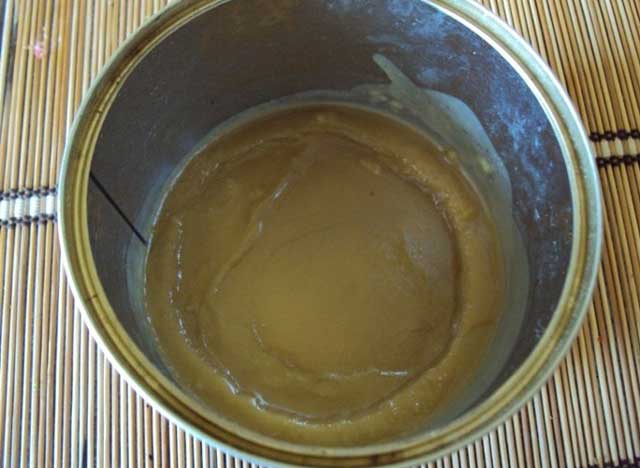
- Wax-containing coatings are more suitable for areas with high humidity levels. After use on the surface of wood, a moisture-proof, heat-shielding film, resistant to ultraviolet radiation, is formed. The resulting coating differs in good heat and frost resistance. In addition, it gives the surface shine. Depending on the composition, it can be either soft-matt or glossy. This is an excellent option for protecting the lining from the lining on the balconies of houses located in regions with difficult climatic conditions, for example, with constant fluctuations in temperature or humidity.
- treatment with antiseptic or primer, close in color with the main dye;
- direct application of paint and varnish materials.
Preparatory work

First of all, the strips are cleaned of dirt and debris of the previous coating.
- Pollution is cleaned using materials such as rough brush, sandpaper or pumice.
- Old paint and varnish are removed in several ways:
- chemical - with the help of specialized means;
- mechanical, which is used in the case of too thick or very old layers of paintwork;
- thermal, which involves the preliminary heating of this layer.
Particular attention should be paid to the presence of possible cracks and chips on the surface of the lining. These areas, as well as places of potential formation of defects, are carefully treated with sandpaper.
Working with antiseptics
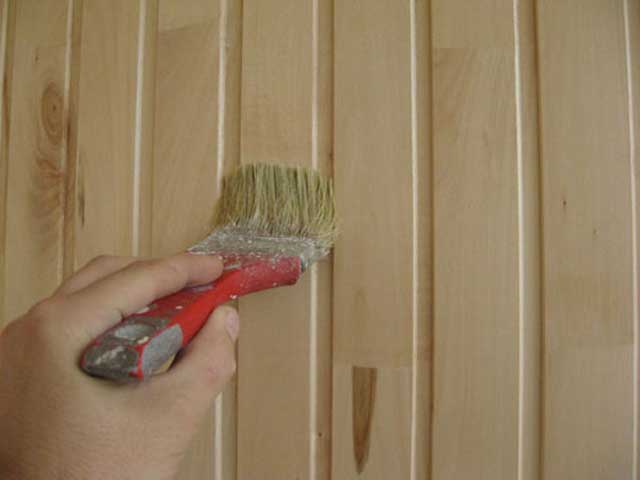
Given the high humidity level on the balcony, you can expect the appearance of fungus. Therefore, wood panels must necessarily be treated with an antiseptic:
- translucent coating compositions that do not overlap the texture of the wood;
- opaque coating compositions that overlap the texture;
- in the case of an unglazed balcony, it is also necessary to apply a water repellent layer;
- it is desirable to further treat the tree with a fire retardant;
For reference!
Antiseptic solutions not only prevent the emergence of fungus and mold. They are able to serve themselves as a decorating layer.
- The resulting layer must dry, after which it is ground.
Application of paint and varnish material

Lacquer (paint) is applied with a roller or brush. In some cases, also use a spray gun. Apply the formulations along the strip in a thin layer, producing long, continuous movements. The more complicated the operating conditions of the lining, the more layers must be applied (at least three).
- Before applying the dye to the previous, well-dried layer, its surface is treated with a zero skin so that the dye stays flat and no stains are formed.
- The last layer is applied from top to bottom so that unwanted bubbles and stains do not form on the surface.
- It is recommended to carry out works on warm days at normal humidity of air. In this case, the paint (varnish) will dry evenly.
Note!
Working with chemical compounds, you need to be particularly prudent. The work is carried out, observing the precautionary measures: they wear tight gloves, and the eyes are protected with glasses, the premises are ventilated.
Natural wood is a highly ecological, safe and popular finishing material in our time. The most convenient and easy to install is a wooden lining, it is trimmed with balconies, loggias, terraces, living rooms, kitchens. Along with its positive qualities, wood is a fairly vulnerable material. Wood easily absorbs moisture, which can deform, from exposure to high temperatures, the lining can dry up. The simplest and most reliable protection for wood is a properly selected coating (varnish, paint). About what to paint a lining inside the house and our conversation will go.
What is the color of the lining inside the house and outside, and what can be done with the wooden board except for the paint?
For the processing and protection of lining there are several types of materials:
- lacquers (create a transparent or translucent film),
- impregnation (absorbed into the wood and virtually invisible, often topped with varnish or paint on top),
- paints (create a strong color film on the surface of the tree).
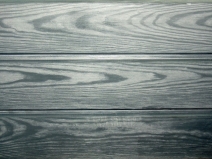
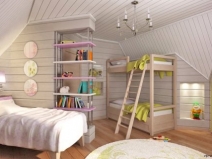
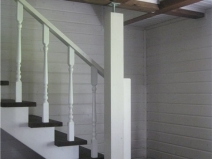

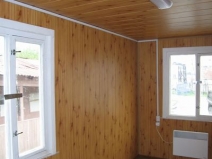
Those who do not like the look of a painted lining in the interior, you can use stain, it emphasizes the texture of the tree and gives a characteristic color. However, the stain weakly protects the surface from moisture and is often topped with varnish or wax. Also, impregnation, which enhances the water-repellent properties of the lining, uses linseed oil. However, eventually the drying oil will darken, and at first it exudes a strong characteristic "aroma". If you are going to process a linseed lining in a residential area, keep this in mind.
Selecting material for wood processing, first of all, be based on what kind of interior you create. If you want to preserve the color and texture of a tree - use transparent impregnations and varnishes. Information on the label will help you choose the appropriate type (with antiseptic action, water repellent, etc.). If you want to implement any color solution and have already decided what color to paint the lining, then you will need a special paint for the lining inside the house. For outdoor works, special paints are also used, on which their purpose is indicated. When choosing a paint, do not hesitate to smell the contents of the cans, and if a very strong "ambre" comes from the paint, then better refuse to purchase. The lining, painted with fetid paint, will exude this fragrance for a week, or even more. Remember that maintaining a healthy environment in the home is one of the main tasks of repair.

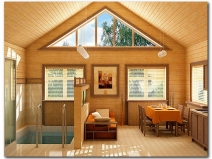
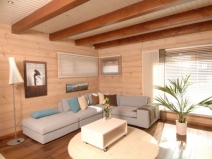
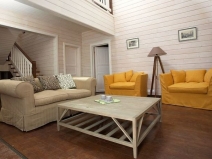
The tool required for painting the lining inside the house:
- brush, roller,
- paint tray, bucket,
- fine-grained sandpaper or special grinding mesh (to eliminate small roughness on the surface of the lining),
- stepladder (for painting the top of the ceiling and ceiling),
- safety glasses, gloves.
The scheme of the work is quite simple:
- cleaning surfaces (from dirt, roughness, old paint, if any),
- primer (for better adhesion of paint to the surface and protection from mold and fungus),
- painting (paint applied in two layers, sometimes in three layers).
To the surface there are no traces of the brush, the painting of the lining (the photo clearly shows) should be carried out smoothly from top to bottom.
Painted paneling in the interior: what color to choose for painting walls in a room or on a balcony?
That the painted lining in the interior looked harmonious and beautiful, you need to choose the right color. To a warm color range the color is from light beige, yellow to brown. To cold colors are: blue, blue, gray. Remember also about the visual perception of color, white color "expands" the space, the lining of black color will make the room gloomy, dark and small.
You can paint the lining in one color or combine several shades, painting the bottom with a darker color (highlighting the bottom as a "panel"), and the top with a lighter shade. For a special originality, you can paint vertical stripes of different colors. Painting tape, small brushes and colorful paint, in conjunction with your imagination, will help create a real masterpiece, turning a boring wall into a bright and unique art object.
Features of work with lining
How to paint the lining inside the house?
Wood is an excellent building material, widely used for interior decoration of premises for various purposes. Wrought walls well conceal uneven walls and give them a flat surface. In addition, the walls of the lining have excellent sound insulation qualities, reflecting almost 100% of the sound. The material itself has a beautiful appearance, but in time it may darken. How can I paint the lining to extend the life of the lining and give it an aesthetic look? As a rule, the painting of the lining is made by ordinary canopies: Panels-Yassia, Panels-Yassia Arctic (with mother-of-pearl), Seneshem Aquadecor, Tikkurila, Eurotex. Floors from the lining in the room are covered with alkyd lacquers such as Eurotex or Unique Super.

Features of painting lining on the balcony and loggia
The most economical option for finishing the walls on a loggia or balcony is its lining with a lining. Wooden materials create good warmth and sound insulation, give the balcony a cosiness and comfort, have the ability to absorb excessive moisture. For the paneling of the balcony, pine is used most often, but in some design decisions a narrow block house and imitation of the beam are used, giving the construction a noble look. Over time, under the influence of atmospheric phenomena, the material can lose its appearance: darken or, conversely, burn in the sun, crack, dry out or swell from excess moisture. To extend the service life and keep a presentable appearance, the products should be varnished or impregnated. A good way to protect is painting the vagonki on the balcony. The better to paint a balcony or loggia, upholstered in wood? For this purpose, use akvalalki, for example: Panels-Yassia Arctic, Unique Super, Eurotex and Senezh Aquadecor. 
Why do many designers use clapboard?
Decoration of the interior of any room with a tree gives it elegance. This type of finishing is appropriate in a country cottage, and in a panel apartment. The use of lining in the interior in addition to what allows you to give the room a unique comfort, but also a natural insulation and soundproofing. Well dried and impregnated with special means, fitted one to the other, the Euro-lining hides all the cracks and irregularities of the walls, making the surface even and beautiful. In addition, the material has good strength and resistance to mechanical damage, so this kind of finish will retain a presentable appearance for many years. Under this cover, you can well hide electrical wiring, heating pipes and water. Due to all these qualities, lining is widely used by designers in the design of various interiors of residential and office spaces.
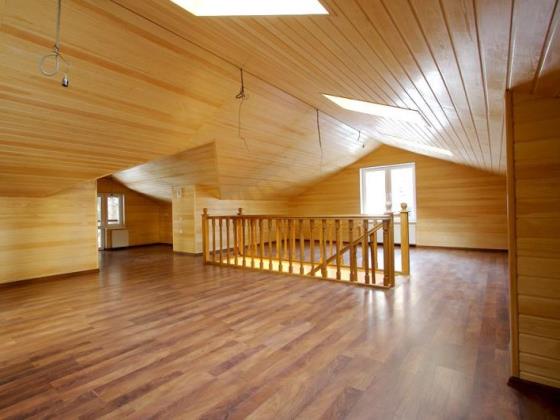
Paint features
The procedure for painting the wooden lining begins with the removal - "stripping" - of the resin with the help of a solvent and putty of cracks, cracks and marks from the knots. Then follows the grinding of the wooden surface. The better the preliminary work, the more even the paint will fall. On uneven protruding areas its layer will be thinner, which means it will collapse more quickly under the influence of atmospheric phenomena. How correctly to paint a lining? For these purposes, water-based colorants are used. Staining is done only with a brush, so you do not need to buy a platen. Brush you need to choose a quality one. The thickness of the tone can be adjusted based on your own preferences. Movements with paint brush should be smooth and uniform, as shown in the photo.

Subtle colors of the lining white
White lining in the interior looks elegant and elegant, so many designers recommend to paint products from this material in white. Coloring in white is a laborious process, and much effort should be made to ensure that the final version satisfies the customer. The lining is well painted with acrylic and oil paints, both polyurethane or latex. These paint and varnish materials have high resistance and durability. In addition, they have good decorative characteristics. After selecting the paint, you should carefully prepare the surface: clean it of dust, dirt and old coating, sand the surface with fine sandpaper and cover with a special impregnation. Coloring is done in two layers. After the second coat has dried, the finishing layer of the special varnish is applied, which allows to fix the already applied coating and gives the surface a special shine. 
We paint the lining correctly!
The painted lining is more durable, does not dry up and does not get dark. In addition, the interior, for example, a children's room or kitchen, involves finishing with a lining of any color. What is beautiful to paint the lining? Modern designers prefer acrylic awnings of different shades. They are easy to apply, safe for human health and quickly dry. You can achieve the desired shade yourself by adding a solution to toning a certain color in a colorless acrylic lacquer, or you can buy a ready-made lacquer varnish. In dry rooms, the material is covered with special impregnation, wax or oils, which preserve the woody color, emphasizing the natural pattern and retaining the texture pleasant to the touch. 
In what color should I paint the lining?
When choosing a shade for painting a lining you need to focus on the style of the interior and the general idea of the designer. The color should not contrast with the floor, ceiling and furniture, unless this is implied by the design. If you do not know how to paint the lining, you can not choose a shade, then, perhaps, a few simple tips will help you. In the interior of the kitchen, the warm flowers look great: pink, orange, yellow. But the shades of gray and blue give a sense of dampness and cold. Cold shades will be appropriate for the office, and for the bedroom the natural color of wood is suitable. Grayish, "aged" lining perfectly emphasize for the interior in the style of "country". White color is very effective and suitable for any style, but such surfaces are sufficiently marble and quickly polluted. In the nursery you can use different ways of combining - the painted lining is painted in different colors. 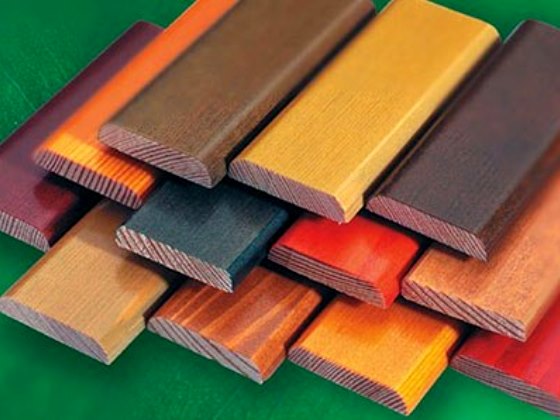
How to choose the paint for the lining?
Professionals choose paint for lining based on the objectives pursued. In general, a variety of materials are used to treat the wooden surface: coating, coating antiseptics, acrylic, oil paints, alkyds and acres. Each of these materials gives certain qualities to the boarding. For example, oil paints are well absorbed and do not allow moisture to pass through. But this surface dries slowly, and eventually loses color and burns in the sun. Acrylate paints retain color well, they allow the surface to breathe and do not crack, but they cost more than oil. Acrylic awnings are usually used indoors. These substances are environmentally friendly and do not cause allergies. Alkyd varnishes are suitable for flooring, because they are solid. That is, choose the paint for the lining follows, based on the goals, interior space, material capabilities and personal preferences. 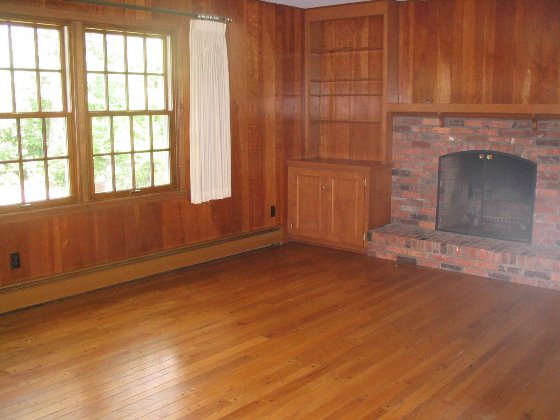
- Protective Coatings
- Decorative coatings
- Surface preparation
- Practical recommendations
Feeling on themselves all the advantages of natural wood, many do not want to give it up. Especially since many have already become saturated with plastic and wallpaper, naturalness again comes into fashion.
To the choice of paint for the lining must be approached very carefully, because an incorrectly thought out solution can spoil the entire appearance of this material.
Therefore it is not surprising that a wooden paneling is in the price category above the average, but at the same time, almost everyone can afford this material, because the price directly depends on the type of wood from which the lining is made. And if you are just going to sheathe the walls or you already have walls lined with walls, it will still be a question of how to paint the lining inside the house.
You can decorate the walls with a lining from the outside, and from the inside. But most masters and designers prefer wood as a material for interior decoration of a room. Finishing the facade with wood is possible, but still it is a street, there is snow and rain and wind, and frost, and high humidity do not influence the tree in the best way.
And why is it so necessary to paint the vagonki inside the house, because there will be no rain, no snow, no fogs, no other negative factors? Yes, there are cases that the lining is not covered and left in its original form. Yes, the natural tree has its own individual pattern, color and texture, it looks beautiful and stylish in any room, however, finishing is still necessary.
The reasons for painting the lining are
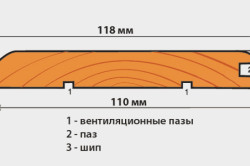
- Lining is a sheet of wood, and wood is a flammable material. Of course, no coating will give 100% protection against fire, but there are special protective compounds (fire retardants) that significantly increase the protection of the material from fire.
- All natural materials become rotten with time. This is a natural process. But it can also be stopped if covered with a special compound. These are antiseptics. The lining can not be painted, but it is necessary to cover with an antiseptic.
- Special coating protects against mechanical damage, from scratches and cracks. Having a solid layer on the tree, it takes the whole impact on itself and at the same time does not allow the formation of cracks.
- In the sun the tree does not lighten, on the contrary, it gets dark. Therefore, the protective coating protects from exposure to sun rays, thereby preserving the natural color of the tree.
- Aesthetic appeal. With the help of colorless varnishes, you can give the tree only a shine or a little shade. There are also paints that completely hide the original color underneath, preserving only the structure of the tree.
Back to contents
Materials for painting lining
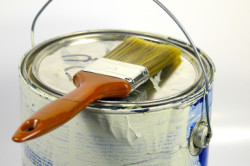
In order for the lining to shine and its color to be uniform, stir the paint carefully before starting the work.
What material is best to paint the lining from inside the house? There is no unambiguous answer, because the choice of material depends on what you want to achieve. If you only need to protect the coating from insects, rodents, fungi, mold and rot, then it will be enough antiseptic. If you want to give shine, then you need a wood varnish. If you give a color, then there are decorative coatings.
At the moment, a wide range of various coatings and impregnations for wood are presented in construction shops. Conditionally they can be divided into two types: for protection and for decoration.
Back to contents
Protective Coatings
Fire retardants protect wood materials from fire. However, a better flame retardant coating is given by factory processing, since it is applied under high pressure and evenly. Handling by yourself does not give such a result.

Before painting the lining, it must be treated with an antiseptic to protect it from mold, black spots and insects.
Antiseptics are compounds that kill bacteria and prevent their further reproduction. Basically, these funds on the same basis and protect against fungi, mold, insects and decay. However, when buying, it is worth paying attention to the type of work of the chosen tool. The label should be written "for internal work". If you are looking for what to paint the lining inside the house without changing its color, antiseptic is what you need.
Acrylic lacquer on a water basis is created for both protection and decoration. They are transparent and translucent. They can be tinted. You can apply a clear coat of the first layer, and the second - with the necessary shade, but the relief and structure of the tree will be preserved.
If a room in a house that is covered with a lining is not used for permanent location, for example, a balcony, synthetic varnishes can be used. They contain substances such as xylene and toluene, which are considered harmful to human health. But at the same time, this varnish falls as smoothly as possible and gives shine.
Wax funds make up a good competition for lacquers. They give a pleasant and semi-glossy shine, and reliably protect the tree from pests. However, there is a minus - such a means is quite difficult to apply.
Back to contents
Decorative coatings
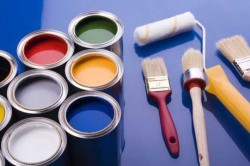
The oil paint for the lining is perfectly absorbed into the wood and does not allow moisture, but can lose color over time.
Painting a vagon with a decorative coating means that the natural color of the tree will be completely hidden. Such means are suitable for the first coating, but initially the natural color of the tree is not needed to hide.
Over time, the tree darkens, and many are bored with the color of the walls. In this case, you can radically change the color. However, there are design solutions, when it is just supposed from the outset that the relief of the tree should be present, and the color of the walls will be completely different. It looks good lining, painted in pastel colors, you can choose a gentle blue or white.
Leader can safely be called oil paint. She is a veteran in the building materials market. Such a long stay among the leaders oil paint deserved by deep penetration into the upper layer of wood, it reliably protects it from damage and moisture, and the coating lasts up to 7 years, while the color does not fade and does not fade. But there are also disadvantages.
Oil paint for a very long time dries and has a rich chemical smell. Therefore, it is impossible to paint it in the cool season, when there is no possibility of round-the-clock ventilation of the house. If the surface is painted with oil paint, it will no longer "breathe". Therefore, the painting of individual objects is not recommended for this paint.
Manufacturers do not sit still, so all the drawbacks of oil paint have been taken into account, and acrylate paint has been produced. It dries quickly, does not have such a rich chemical smell, is suitable for painting inside houses.
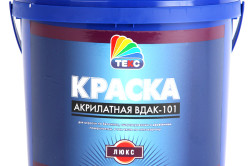
The advantage of acrylate paint is its ability to "breathe", vapor tightness and elasticity. In addition, it retains its color and shine for a long time.
The coating of acrylate paint is elastic, so even under the influence of frost, high temperature, moisture and sun does not crack. Color and shine persist for many years even under the influence of ultraviolet rays. But the drawback is significant - the price of such a paint is much higher than the oil.
Acrylic lacquer on a water basis is created specially for internal works, so it is non-toxic, harmless to human health, suitable for children's room, bedroom, as well as for people with allergies.
If you only need to change the shade of the tree, this task will be perfectly handled by stain.
After you have chosen what to paint the lining, it's time to proceed to the very process of painting. Initially, it is necessary to check all the necessary tools and carry out preparatory work.
Back to contents
What can be useful in the process
You will need the following tools:
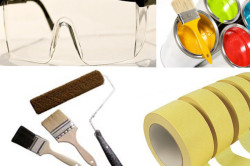
For painting lining you need tools such as: roller, brushes, goggles, scotch, paint and so on.
- gloves;
- stairs-stepladder;
- bucket;
- sandpaper with fine or medium grain;
- spray gun (if possible);
- brush the required width;
- clothes for work, which it is not a pity to throw out;
- means for removing the old paint (if required);
- metal brush;
- tray (for convenience of painting);
- primer;
- wood bleach (if necessary);
- paint, enamel, varnish - depending on what you have chosen;
- impregnation.
